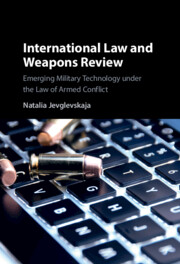Book contents
- International Law and Weapons Review
- International Law and Weapons Review
- Copyright page
- Dedication
- Contents
- Foreword
- Acknowledgements
- Table of Cases
- Table of Treaties and Other Selected Instruments
- Abbreviations
- 1 Introduction
- 2 Article 36: Background and Historical Development
- 3 Interpretative Methodology
- 4 Interpreting Article 36: The Object of Review
- 5 Interpretation of Article 36: The Process and Standard of Review
- 6 Weapons Review Obligation under Customary International Law
- 7 Weapons Reviews under the System of AP I
- 8 Challenges to Article 36 Reviews Posed by Autonomous Weapons Systems (AWS)
- 9 Challenges to Article 36 Reviews Posed by (Autonomous) Cyber Capabilities
- 10 Concluding Remarks
- Index
3 - Interpretative Methodology
Published online by Cambridge University Press: 16 December 2021
- International Law and Weapons Review
- International Law and Weapons Review
- Copyright page
- Dedication
- Contents
- Foreword
- Acknowledgements
- Table of Cases
- Table of Treaties and Other Selected Instruments
- Abbreviations
- 1 Introduction
- 2 Article 36: Background and Historical Development
- 3 Interpretative Methodology
- 4 Interpreting Article 36: The Object of Review
- 5 Interpretation of Article 36: The Process and Standard of Review
- 6 Weapons Review Obligation under Customary International Law
- 7 Weapons Reviews under the System of AP I
- 8 Challenges to Article 36 Reviews Posed by Autonomous Weapons Systems (AWS)
- 9 Challenges to Article 36 Reviews Posed by (Autonomous) Cyber Capabilities
- 10 Concluding Remarks
- Index
Summary
Chapter 3 explains the interpretative methodology adopted in this book. It shows that the process of interpreting the law of armed conflict, including Article 36, has so far been lacking transparency both in practice and scholarship. It has been largely marked by presenting the outcomes of interpretation rather than explaining how these outcomes were achieved. To ensure that giving meaning to the terms of Article 36 will proceed in a transparent and principled manner, this chapter addresses the shortcomings of Articles 31 and 32 of the Vienna Convention on the Law of Treaties and suggests an interpretative methodology that helps overcome its limitations. The chapter also draws on the ideas of Stanley Fish and his work on interpretative communities. Thus, interpretation is here understood as a process of ascribing a meaning from a suite of possible meanings to convince the relevant interpretative community that a certain interpretation is the most persuasive interpretation to adopt. The interpretative community includes States, courts and tribunals, the International Committee of the Red Cross, non-governmental organisations and legal, military and academic experts. [177 words]
Keywords
- Type
- Chapter
- Information
- International Law and Weapons ReviewEmerging Military Technology under the Law of Armed Conflict, pp. 50 - 86Publisher: Cambridge University PressPrint publication year: 2021

